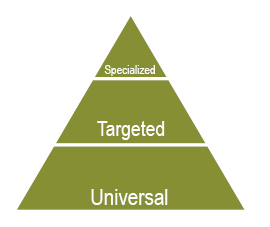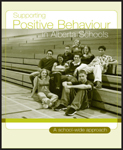
|
Universal Supports benefit all students
- Help students develop an understanding of how to make and sustain friendships through class discussion, examples from literature and
role-play. Use graphic organizers such as T-charts to brainstorm what friendship behaviour looks like, sounds like and feels like.
- Use the language of friendship and community throughout the school day to encourage students to consider all classmates as friends and to treat one another with kindness and respect.
- Develop classroom routines that promote and facilitate friendships by providing multiple opportunities for students to interact and work with one another. Structure for success by providing efficient and inclusive strategies for forming small groups and assigning partners.
- Teach, practise and review specific skills for successful social interactions, such as welcoming a new person into the group, asking to join a group, demonstrating active listening, contributing to the group task, inviting a peer to participate, or giving positive feedback.
- Post visual reminders of
strategies related to making and sustaining friendships.
When appropriate, collaborate with students to develop these
visual reminders.
- Use descriptive feedback to reinforce individual students, groups of students and/or the whole class when they demonstrate friendly behaviours.
|
|

|
Targeted Supports benefit students with more specific needs
- Pair individual students with positive peers who can serve as role models and provide social support. Rotate these peers at regular intervals throughout the school year.
- Provide proximity by positioning yourself nearby individual students who may require support and encouragement in working with others.
- Work with individual students to develop low-key cues and prompts that you can use to remind them to use their friendship skills.
- Provide personalized visual checklists for targeted friendship strategies and place them on the students' desks where they can see and use them independently. Some students may wish to carry the checklists with them.
- Develop self-monitoring strategies for students to reflect on and keep track of how well they get along with others.
- Set up a systematic approach to reinforcement for students who are working on improving their relationships with others.
|
Parents know their children well and can offer insights on how to support
their social and emotional well-being. There is strength in collaborating
on strategies that could be used at home, at school and in the community.
|

|
Specialized Supports benefit the small number of students with sensory, physical, cognitive or behavioural needs that require intensive, individualized interventions
- Some students may benefit from a structured circle of friends approach in which peers are actively recruited and coached to provide friendship and support.
- In exceptional cases, an individual student may need 1:1 adult support to facilitate communication and social interactions with others. This support should be provided as unobtrusively as possible. In addition, the adult providing this 1:1 should collaborate with the student's learning team to identify and facilitate as many ways as possible to create opportunities, provide strategies, modify activities and adjust and/or fade support so the student can experience some degree of independence in relationships with peers throughout the school day.
|
|








